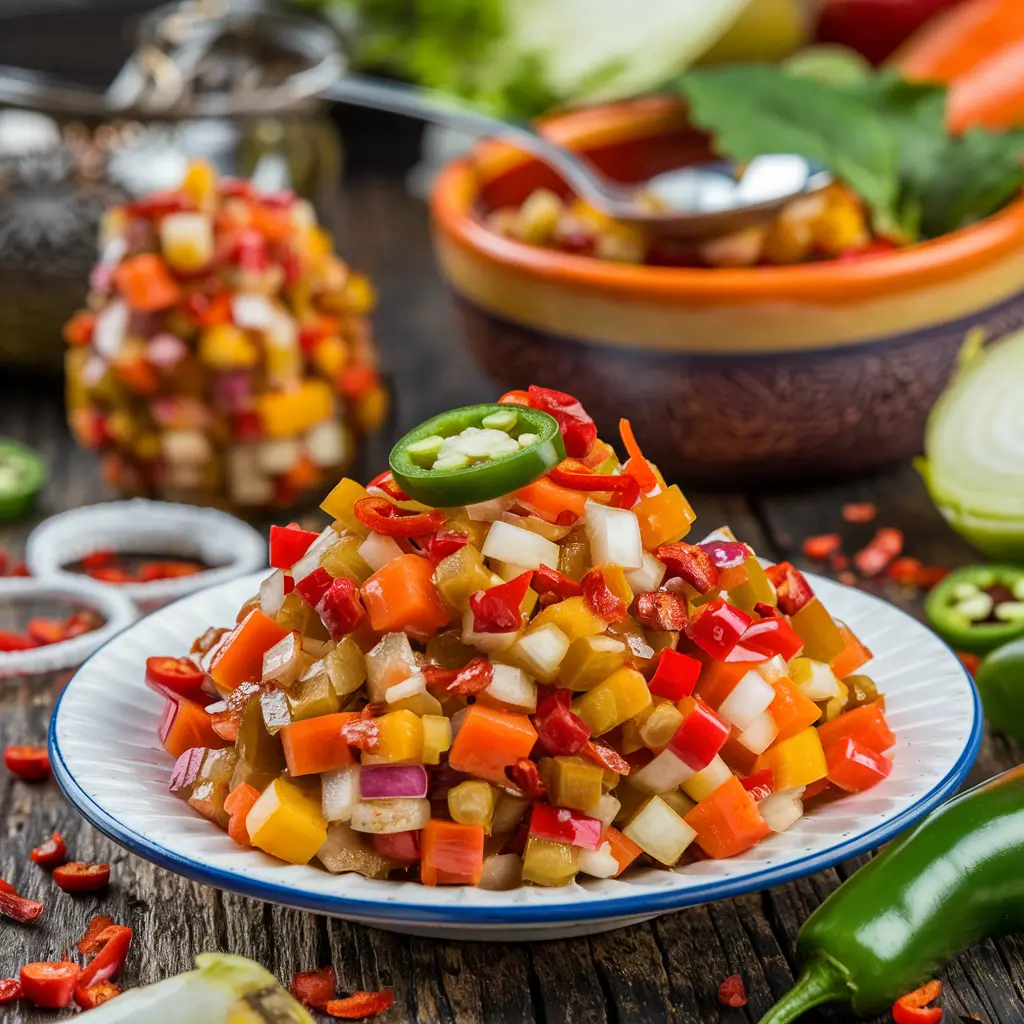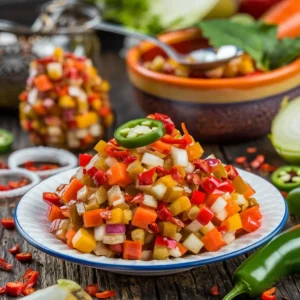Introduction
In the diverse world of vegetarian cuisine, few condiments hold the distinction and versatility of Chow Chow. This traditional relish, with its complex flavors and rich history, has evolved from a practical preservation method to a celebrated component of modern vegetarian cooking.
- Introduction
- Historical Significance and Cultural Impact
- The Science of Pickling in Chow Chow
- Comprehensive Ingredient Analysis
- Advanced Preparation Techniques
- Regional and International Variations
- International Influences
- Modern Adaptations and Innovations
- Dietary Modifications
- Professional Tips and Techniques
- Culinary Applications
- Creative Uses
- Nutritional Information and Health Benefits
- Probiotic Benefits
- Seasonal Considerations and Sustainability
- Sustainability Practices
- References and Further Reading
- Academic Sources
- Online Resources
- Conclusion
Historical Significance and Cultural Impact
The origins of Chow Chow are traced back to Chinese immigrants who brought their pickling techniques to North America. The recipe found particular resonance in two distinct American regions: the Pennsylvania Dutch communities and the American South2. Each region developed its unique interpretation, reflecting local ingredients and taste preferences.
Pennsylvania Dutch Tradition
- Focus on cabbage and green tomatoes
- Sweeter profile with more pronounced pickling spices
- Often served with traditional Pennsylvania Dutch dishes
- An integral part of winter food preservation
Southern Heritage
- Greater variety of vegetables
- A more pronounced vinegar profile
- Essential accompaniment to beans, cornbread, and greens
- Strong connection to end-of-season harvests
The Science of Pickling in Chow Chow
Understanding the science behind pickling helps create the perfect Chow Chow:
Chemical Process
- Vinegar’s acetic acid creates an inhospitable environment for harmful bacteria
- Salt draws moisture from vegetables through osmosis
- Sugar balances acidity and aids in the preservation
- Natural fermentation can occur when using traditional methods
Temperature Control
- Proper temperature monitoring during processing ensures food safety
- Consistent storage temperatures extend shelf life
- Heat processing creates an anaerobic environment in sealed jars
Comprehensive Ingredient Analysis
Core Vegetables
- Green Tomatoes
- High in vitamin C and antioxidants
- Provide firm texture and tart flavor
- Best harvested just before the first frost
- Cabbage
- Rich in fiber and vitamin K
- Adds crucial crunch
- Both green and red varieties are suitable
- Bell Peppers
- Multiple colors for visual appeal
- High in vitamins A and C
- Sweet undertones balanced acidity
- Onions
- Contains beneficial sulfur compounds
- Adds depth to the flavor profile
- Both white and yellow varieties work well
- Cauliflower
- High in fiber and B vitamins
- Adds unique texture
- Absorbs surrounding flavors effectively
Pickling Solution Components
Vinegars
- Apple cider vinegar (5% acidity)
- White vinegar (5% acidity)
- Optional: Rice vinegar for Asian variation
Sweeteners
- Granulated sugar
- Brown sugar (optional)
- Honey (alternative option)
Spices and Seasonings
- Essential Spices
- Celery seeds
- Mustard seeds
- Turmeric
- Black peppercorns
- Optional Additions
- Coriander seeds
- Dill seeds
- Red pepper flakes
- Bay leaves
Advanced Preparation Techniques
Vegetable Preparation
- Cutting Techniques
- The uniform size ensures that even pickling
- Small dice (¼ inch) recommended
- A food processor can be used with a pulse setting
- Salt Treatment
- Layer vegetables with kosher salt
- Allow to stand 4-12 hours
- Rinse thoroughly before processing
Brine Preparation
- Vinegar Selection
- The balance of different vinegars creates complexity
- Maintain 5% acidity for safety
- Consider flavor profiles when mixing
- Spice Preparation
- Toast whole spices for enhanced flavor
- Create spice bags for easy removal
- Combine ground spices with vinegar
Regional and International Variations
American Regional Styles
- New England Version
- Includes more root vegetables
- A higher proportion of onions
- Less sweet than Southern-style
- Midwest Interpretation
- Corn and cabbage-heavy
- Milder spice profile
- Often includes carrots
- Southern Traditional
- Green tomato-based
- Spicier profile
- Often includes okra
International Influences
Asian-Inspired Variation
- Addition of ginger and garlic
- Rice vinegar base
- Szechuan peppercorns
- Optional fish sauce (for non-vegetarians)
European Touch
- Mediterranean herbs
- Wine vinegar options
- Addition of capers
- Olive oil incorporation
Modern Adaptations and Innovations
Contemporary Ingredients
- Trendy Additions
- Kohlrabi
- Watermelon rind
- Romanesco
- Multicolored carrots
- Superfood Integration
- Kale
- Brussels sprouts
- Rainbow chard
- Beet varieties
Dietary Modifications
Low-Sugar Versions
- Natural sweetener alternatives
- Stevia incorporation
- Monk fruit options
- Reduced sugar techniques
Salt Alternatives
- Potassium-based substitutes
- Herb-enhanced versions
- Celery juice options
- Seaweed additions
Professional Tips and Techniques
Equipment Essentials
- Required Tools
- Sharp chef’s knife
- Large cutting board
- Heavy-bottom stockpot
- Canning equipment
- pH testing strips
- Optional Equipment
- Food processor
- Mandoline slicer
- Vacuum sealer
- Digital thermometer
Safety Considerations
- Food Safety
- Proper pH monitoring
- Temperature control
- Sterilization procedures
- Cross-contamination prevention
- Storage Safety
- Proper seal verification
- Temperature monitoring
- Container inspection
- Shelf life tracking
Culinary Applications
Traditional Servings
- Classic Pairings
- Bean dishes
- Cornbread
- Vegetarian hot dogs
- Plant-based burgers
- Modern Applications
- Grain bowls
- Buddha bowls
- Sandwich spreads
- Taco toppings
Creative Uses
- Fusion Dishes
- Asian-inspired wraps
- Mediterranean platters
- Mexican-style relish
- Indian chutney alternative
- Unexpected Applications
- Pizza topping
- Pasta sauce base
- Dip foundation
- Salad dressing component
Nutritional Information and Health Benefits
Vitamin Content
- High in Vitamins A, C, and K
- Good source of B-complex vitamins
- Natural antioxidants
- Beneficial plant compounds
Mineral Content
- Calcium from vegetables
- Iron from green vegetables
- Potassium from various components
- Trace minerals from pickling spices
Probiotic Benefits
- Natural fermentation possibilities
- Gut health promotion
- Digestive aid properties
- Immune system support
Seasonal Considerations and Sustainability
Seasonal Adaptation
- Summer Version
- Fresh, local vegetables
- Lighter vinegar profile
- Fresh herb incorporation
- Quick-pickle options
- Winter Version
- Storage vegetables
- Stronger spice profile
- Preserved ingredients
- Longer fermentation
Sustainability Practices
- Ingredient Sourcing
- Local produce usage
- Seasonal adaptation
- Organic options
- Zero-waste approaches
- Storage Solutions
- Reusable containers
- Proper preservation
- Minimal waste techniques
- Energy-efficient processing
References and Further Reading
Academic Sources
- “The Art of Fermentation” by Sandor Ellix Katz
- “The Joy of Pickling” by Linda Ziedrich
- “Preserving Food Without Freezing or Canning” by The Gardeners & Farmers of Terre Vivante
Online Resources
- National Center for Home Food Preservation Official Website
- USDA Canning Guide
Conclusion
Chow Chow represents more than just a condiment; it’s a testament to the ingenuity of preservation techniques and the evolution of vegetarian cuisine. Whether following traditional methods or exploring modern variations, this versatile relish continues to enhance vegetarian dishes while providing significant nutritional benefits.



